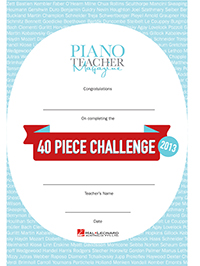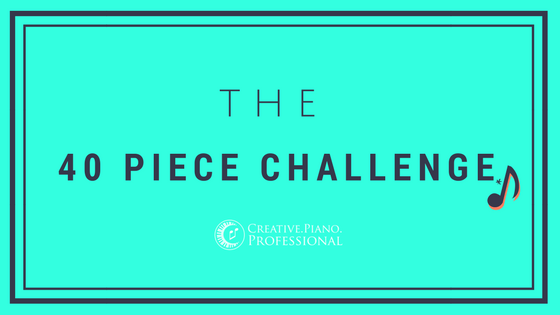For quite some time my studio has run a certificate system for students completing songs. For completing 10 pieces, they received a green certificate, orange for 20, silver for 30 and gold for 40. This was quite an easy achievement for the beginner students with lots of shorts songs being completed.Then some time ago, Elissa Milne wrote this about the 40-piece Challenge here. Then Tim Topham wrote about it and the Hal Leonard 40-Piece Challenge website was also launched. An article on this was also published in the Piano Teachers’ Magazine ( The Piano Teacher 40 Piece Challenge.)

For my beginner students there was no question of their participation in this challenge. It was very close to the system we were already using.
For my late beginner to intermediate students this presented something of a shift in thinking. My students were normally learning 15-20 pieces of repertoire each year, about a year ago after reading Elissa’s blog post, I started experimenting with these students getting them to pick up old books and easier repertoire to get them sight reading more. There have been so many benefits from doing this!
- Students have enjoyed being able to go back to books they once thought were ‘hard’ and quickly pick up the new ‘easy’ piece.
- Having quick-wins is motivational for students.
- At the end of the year they have read SO MUCH MORE MUSIC!! their sight-reading improves, their attention to detail improves and their enjoyment is increased. Just like children bringing readers home from school each day, fluency with music reading needs to develop in a similar fashion. A regularly practised skill.
- You (the teacher) can allocate a quick-win piece that works on a specific technique to get them focusing on strengthening a particular element.
- At particular times of the year you might like to include repertoire such as Christmas Carols, Halloween pieces and other seasonal favourites. In my studio, we don’t usually spend too long on these types of pieces. They are just around for a few weeks, but students love to play them!! This way they can add the pieces to their “Playing-bank” all whilst having plenty of time for other materials.
So far this year, one of my 5th Grade Classical AMEB students has learnt their 6 required pieces for the AMEB exam. In addition to this, they have studied a further 6 grade level songs, 10 or so grade 3-4 songs and many many songs under 2nd grade level (well in excess of 20 more songs). It is not unusual for me to pick out an easy book from my collection and get her to read through and play some easy pieces at lesson when we highlight sight reading.
Not all students are like this. I also have another student who would be pushing it to learn thoroughly to performance standard 4 songs at grade level for the year. We focus very strongly on the mid to easy pieces. This has really helped build her confidence with note reading and overall enjoyment of playing. She would probably play 25-30 total songs for the year.
Much of this challenge has depended on what I as the teacher deem as ‘finished’. For a student to complete a song in the easy/medium category (at their level) I required them to be able to play the piece to me in what I would consider a run-through state. The piece needs to be played in its entirety, rhythm even and steady, at tempo, inclusion of articulation, makings, pedal and dynamics and most importantly being played musically. I’m not a stickler for each and every detail. For their grade-level songs, the end result is normally a polished performance ready piece. This is unless the piece (after some time and effort) just isn’t working for the student. In which case we finish it whenever we can.
Several weeks ago Elissa Milne made a comment in a Piano Teachers’ forum about changing her way of approach and adding students’ songs to their list when they start the piece rather than after they finish. I think for me, this is the final piece of the jigsaw puzzle. The positive reinforcement is given as the choice to learn new material is made. If they don’t complete the piece then it gets taken off the list, giving the feeling of loss to the incomplete song, rather than it just being forgotten about. Students see the progress of their Challenge list grow quickly and are eager to add to it.
So this is my new experiment in the studio, and it seems to be working. Funny how little tweaks to things we already do can create a better learning opportunity for our students!



Reblogged this on 40 Piece Challenge and commented:
It’s great to read how the Challenge is working in piano teaching studios around the world! We love the “playing bank” especially…
One of my student’s Playing Bank is up to 62 since April!! It really is amazing what they can achieve when they are motivated!